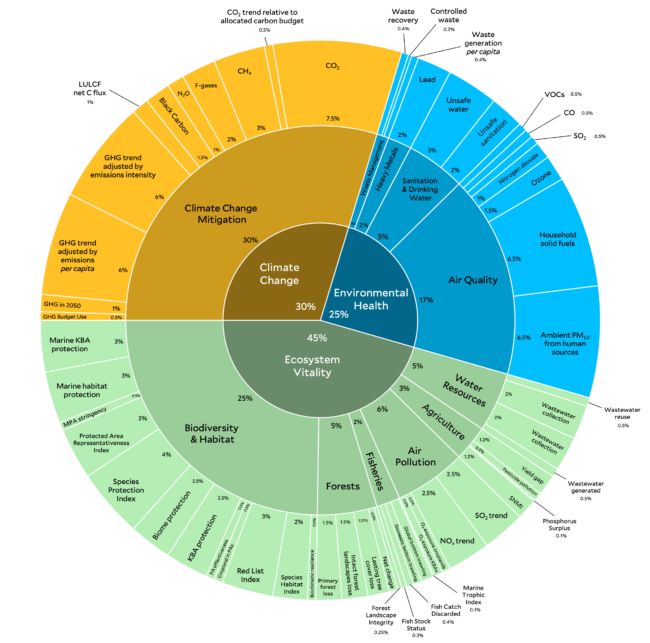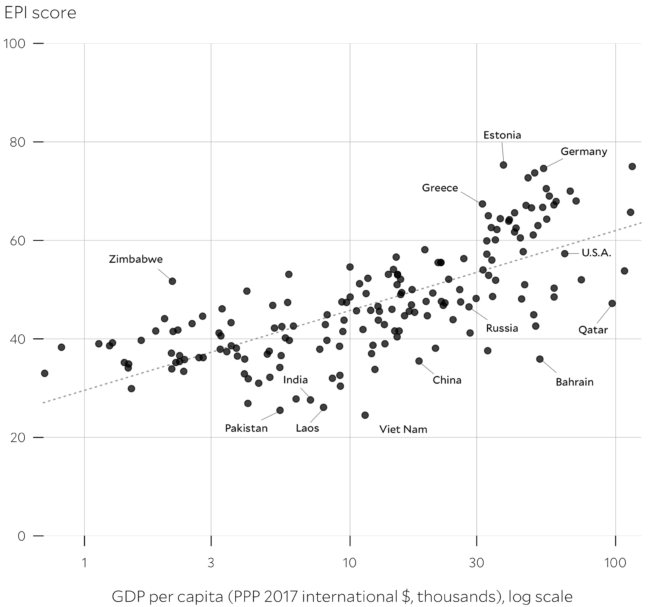As the world continues to face new challenges connected to climate change, how do we tally national and global efforts toward achieving sustainability goals and addressing intensifying environmental concerns?
For the last 25 years, the Center for International Earth Science Information Network (CIESIN) has collaborated with the Yale Center for Environmental Law and Policy on the Environmental Performance Index (EPI)—essentially, an evidence-based and multi-faceted sustainability scorecard.
While there has some been progress toward sustainability in recent years, the 2024 EPI highlights many areas for improvement.

This index offers a summary of sustainability around the world by ranking 180 countries based on climate change mitigation, ecosystem vitality and environmental health. The EPI uses 58 different performance indicators within 11 categories to score each country, track trends and identify successful policy interventions.
The EPI scores are a way to spotlight not only how countries have fared in their efforts to address a wide range of environmental challenges, but also how they compare with one another. They evaluate nations on adherence to the U.N. Sustainable Development Goals, the 2015 Paris Climate Change Agreement and the Kunming-Montreal Global Biodiversity Framework.
The 2024 EPI introduced several new metrics in response to evolving goals and recent environmental reports. For example, this year looked at countries’ progress at curbing their greenhouse (GHG) emissions—evaluating nations on how fast they have reduced their emissions and on how close they are to the net-zero target.
The analysis found that GHG emissions were falling in a greater number of countries than before, but only five had reduced their emissions enough to reach net-zero by 2050 if they continued to cut emissions at their current rate: Estonia, Finland, Greece, Timor-Leste and the U.K.
In the U.S., which is ranked number 34 on the list, emissions are falling but slowly; while China, Russia and India continue to produce greater rates of GHG emissions compared with previous years.

For the first time, the 2024 EPI also introduced new metrics to calculate how well countries protect essential habitats, as well as indicators to measure how effectively protected areas have been regulated by individual countries. These metrics are a direct response to the Kunming-Montreal Global Biodiversity Framework’s goal of safeguarding 30 percent of lands and seas by 2030.
From these new indicators, it is clear that many countries may have reached their area protection goals, but the loss of natural ecosystems continues to be a major challenge. The report points to the importance of adequately funding protected areas and of developing well-regulated environmental protection standards in collaboration with local communities. In 23 countries, more than 10% of the protected land was found to consist of buildings and cropland, while in 35 countries there is more fishing within the marine protected areas than outside.

Overall, index scores were positively correlated with a country’s wealth, though there was a point after which higher wealth led to diminishing returns. No country, however, could claim full sustainability based on the 2024 EPI.
With increased wealth, countries can fund better infrastructure for essential needs like cleaner drinking water and waste management, as well as expand renewable energy efforts. However, wealthier countries are also responsible for higher consumption, leading to more GHG emissions, waste generation and ecosystem destruction.
The EPI offers a warning to developing countries to avoid the mistakes made by wealthier nations on their path to industrialization. It also includes an important reminder to wealthier countries to beware the overconsumption that leads to environmental degradation and to help invest in developing nations to ensure a better and more sustainable future for the entire planet.




No Comments
Leave a comment Cancel